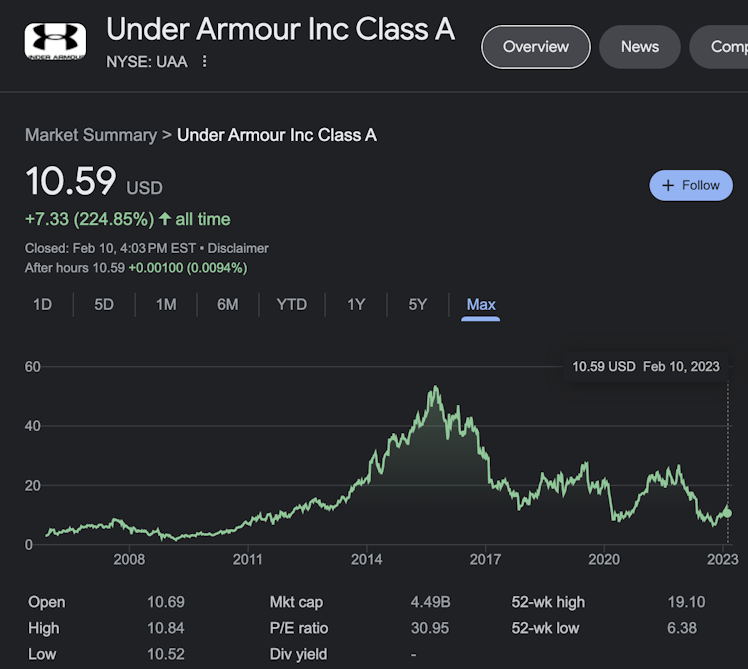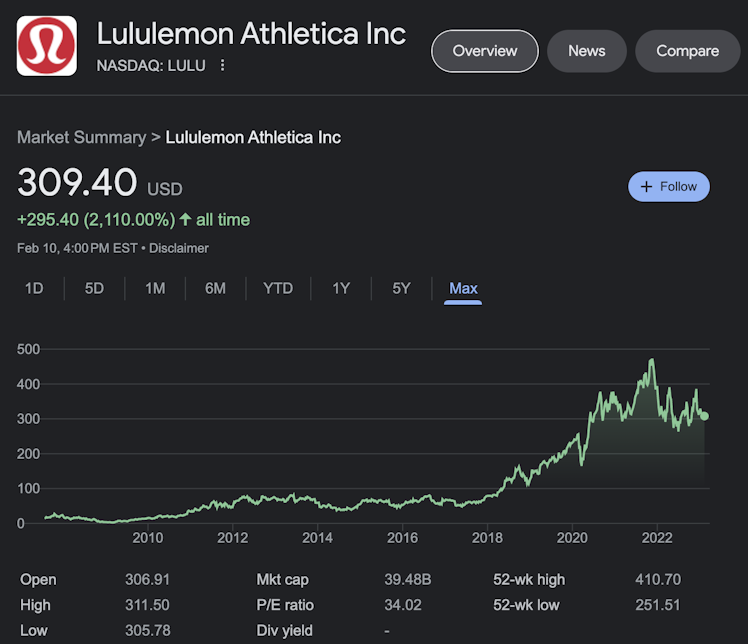Trending Assets
Top investors this month
Trending Assets
Top investors this month
Will these retail brands see success like Lululemon or struggle like Under Armour?
Outside of the old and dominant retail brands like Nike $NKE and Adidas, during the 2010s, we've seen the emergence of two new mainstream retail brands: Under Armour $UAA and Lululemon $LULU
Under Armour was known for being the first to turn mositure-wicking sports apparel into a massive business. Before Under Armour, moisture-wicking apparel was expensive and brands didn't see much value in it. Reading the history of Under Armour, one would think that by being the first to create moisture-wicking sports apparel that would keep athletes cool and dry while they exercised, that they would be able to come ontop of Nike.
Looking at the stock performance of Under Armour, it didn't look to be the case as other athletic retail brands like Nike and Adidas started jumping on the moisture-wicking sports apparel niche. While Nike and Adidas relied immensely on third party retailers like Footlocker $FL and Dick's Sporting Goods $DKS to help with sales, Under Armour wanted to remain a DTC-brand. Being a DTC brand is difficult and because of that, Under Armour struggled to compete against its bigger peers. Also, Under Armour approached fashion from a technical perspective than a simplicity perspective, deterring most consumers since they have simpler needs than professional athletes.

Then, we have Lululemon. Lululemon was the pioneer of the athleisure. The founder, Chip Wilson, knew that there will be a shift in fashion attitudes at the gym where people will go from wearing their worst clothes at the gym to try and be fashionable at the gym. Even before Lululemon became a major player in the retail industry, the business had a history of innovation. Nike and Adidas also have a history of innovation and their businesses grew as they created more innovations.
Unlike Under Armour, Lululemon was seen as a "status symbol" and was riding a growing trend in society. That trend is the growing popularity of yoga. Since Lululemon was already a notable brand in the yoga community, the brand was riding the growth of yoga. Even as other brands made their own yoga pants, because celebrities chose to wear Lululemon yoga pants instead of Nike yoga pants or Adidas yoga pants, Lululemon became a status symbol.
As we can see, Lululemon has provided enormous returns for investors. Even as people thought they were late to invest in the athleisure trend back in 2018, the stock continued to roar and outperform the market!

Now, after seeing two popular retail brands go in two different directions, the question is, how will the other up-and-coming retail brands perform?
For brands that saw success from making all their products sustainable, like Allbirds or On Holdings, only time will tell if these brands can succeed. On Holdings has the backing of tennis legend Roger Federer and it wouldn't be surprising if Federer continues to promote the On brand even as he retired from professional tennis. The tennis champion is known for being a Mercedes Benz promoter and being attributed to a luxury brand allows Federer to make On look like a luxury sustainable brand. For Allbirds, they were a popular shoe brand for the VC community. In case you forgot, during the last few pre-pandemic years, Silicon Valley was obsessed with Allbirds.
Despite losing the obsession that the VC community once gave Allbirds during the late pre-pandemic days, Allbirds continued to grow their sales.

(source)
Unlike Allbirds, On never had never received the level of obsession that Allbirds once had. But the company continues to grow. Even if I've only seen two people in my life (so far) wear On running shoes and plenty of people wear Allbirds, On can still succeed as a niche sustainable luxury brand. Some will say that the two brands will see their future closely resemble that of Under Armour and others will say it could be the next Lululemon in the making. Only time will tell.
And speaking of luxury brands, Canada Goose $GOOS is a notable Canadian luxury brand. They're known for making jackets that are great at keeping you warm during the winter. Surprisingly, they're also a necessity for researchers working in Antartica. Canada Goose is a status symbol. Even if they're not as well known as Louis Vuitton, criminals can recognize a Canada Goose jacket.
Even if Canada Goose is the elite's winter coat, the brand isn't known for sustainability. If anything, their growth leads to the increased killing of ducks and coyotes. LVMH, the largest fashion conglomerate in the world, has its success linked to the rise in animal cruelty. Even if younger generations support sustainability and animal rights, they continue to buy Lousi Vuitton bags and other products from LVMH. It wouldn't be surprising if younger consumers will look away from the animal cruelty aspects of Canada Goose and continue to buy their coats, especially since their coats help people go outside comfortably in colder regions. Overall, if Canada Goose continues to maintain its status symbol appeal, then it has a great chance at achieving success.
And finally, $FIGS. Their scrubs are a new trend among healthcare workers. Even though FIGS will struggle to dominate the scrubs market for a variety of reasons, the fabric is where I see value for the brand. According to the Invest like the Best podcast episode with Trina Spear, the fabric that makes FIGS's scrubs amazing took 5 years of development. The fantastic protection it holds against liquids along with its breathability makes the fabric ideal for athletic clothing. As long as they can successfully expand into other types of clothing (like athletic clothing or casual clothing), I think that FIGS can be successful. The odds are in their favor.
To conclude, it's difficult to predict whether a brand will succeed in the face of competition or not. Even if they end up struggling in the face of competition, it's worth noting that their emergence and initial success in retail hasn't come in vain. They bring innovations that push other retail brands to adopt so that they can provide consumers with products that provide better performance, that are made using environmentally-friendly materials, and that can provide solutions to problems that people might face in daily life (i.e. enduring with the cold weather).
Apple Podcasts
Invest Like the Best with Patrick O'Shaughnessy: Trina Spear - Billion Dollar Scrubs on Apple Podcasts
Show Invest Like the Best with Patrick O'Shaughnessy, Ep Trina Spear - Billion Dollar Scrubs - Sep 20, 2022
Already have an account?